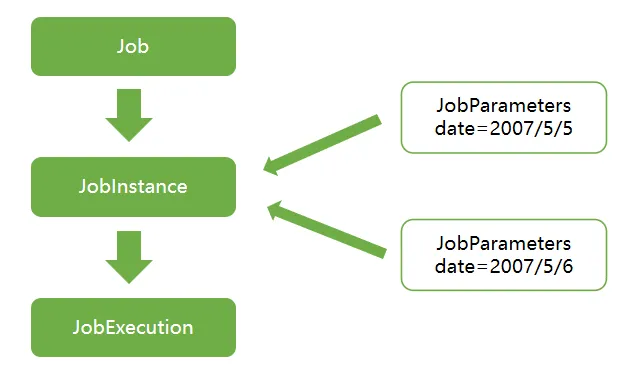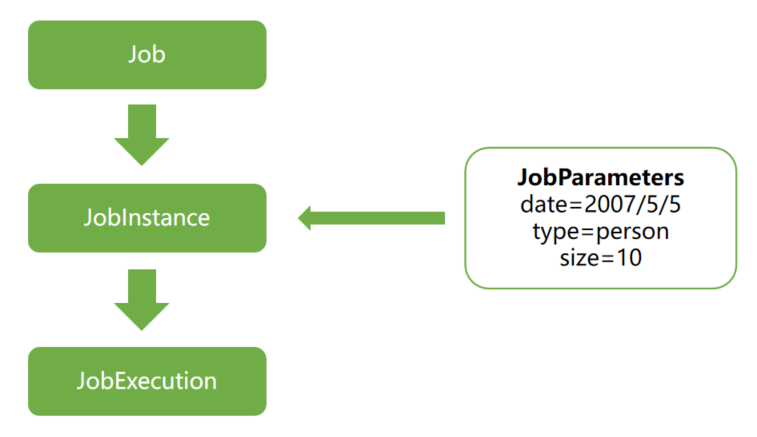前面章节提供的所有示例的 Step 实现中均是简单的输出一段文本到控制台,然而真实场景中不可能如此简单。通常我们在启动一个 Job 的时候,或多或少都会携带一部分参数过去。在 Spring Batch4 核心概念 章节指出,我们通常使用“Job + JobParameters”来唯一确定 JobInstance 对象。如下图:

上图存在两个 JobParameters,它们内部保存了一个 date 字段。因此,也就存在两个 JobInstance,本章将详细介绍 JobParameters。
在 Spring Batch 4 中,JobParameters 用于封装作业执行时所需参数的核心组件。它为作业提供了参数化执行的能力,并确保作业实例的唯一性。
JobParameters 的定义
JobParameters 表示批处理作业运行时参数的值(Value)对象。由于这些参数在其所包含的 JobParameters 之外没有单独的意义,因此它是一个值(Value)对象而非实体。为了确定一个 JobParameters 对象是否等于另一个,参数对象能够可靠地与另一个进行相等性比较也极为重要。此外,由于这些参数需要被持久化,因此限制所添加的类型至关重要。
注意,一个 Job 通常需要多个参数,因此在 JobParameters 内部使用一个 Map 来保存 Job 的所有参数,Map 的定义如下:
private final Map<String,JobParameter> parameters;
如下图:

下面是 JobParameters 的部分源码:
package org.springframework.batch.core;
import java.io.Serializable;
import java.util.Collections;
import java.util.Date;
import java.util.LinkedHashMap;
import java.util.Map;
import java.util.Objects;
import java.util.Properties;
import org.springframework.lang.Nullable;
@SuppressWarnings("serial")
public class JobParameters implements Serializable {
// 内部存储的参数
private final Map<String,JobParameter> parameters;
public JobParameters() {
this.parameters = new LinkedHashMap<>();
}
public JobParameters(Map<String,JobParameter> parameters) {
this.parameters = new LinkedHashMap<>(parameters);
}
/**
* 针对所提供 key 对应的 Long 类型值的类型安全获取方法。
* @param key 要获取值得 key
* @return Long 值,如果 key 不存在,则返回 null
*/
@Nullable
public Long getLong(String key){
if (!parameters.containsKey(key)) {
return null;
}
Object value = parameters.get(key).getValue();
return value==null ? null : ((Long)value).longValue();
}
// ...为了节省篇幅,将其他 getXXX() 方法省略...
/**
* 获取所有参数,包含 string, long, date...
*
* @return 一个包含所有参数的不可修改的 Map。
*/
public Map<String, JobParameter> getParameters(){
// 使用 Collections.unmodifiableMap() 方法修饰 Map,Map 不允许被修改,
return Collections.unmodifiableMap(parameters);
}
/**
* 判断参数是否为空
* @return 如果参数为空则返回true,否则返回false。
*/
public boolean isEmpty(){
return parameters.isEmpty();
}
@Override
public boolean equals(Object obj) {
if(obj instanceof JobParameters == false){
return false;
}
if(obj == this){
return true;
}
JobParameters rhs = (JobParameters)obj;
return this.parameters.equals(rhs.parameters);
}
@Override
public int hashCode() {
return 17 + 23 * parameters.hashCode();
}
@Override
public String toString() {
return parameters.toString();
}
// 将参数转换成 Properties
public Properties toProperties() {
Properties props = new Properties();
for (Map.Entry<String, JobParameter> param : parameters.entrySet()) {
if (param.getValue() != null) {
props.put(param.getKey(), Objects.toString(param.getValue().toString(), ""));
}
}
return props;
}
}
JobParameter 的定义
从上面可以知道,JobParameter 是被包含在 JobParameters 内部的 Map<String,JobParameter> 中,一个 JobParameter 代表一个具体的参数。
JobParameter 是批量作业参数的域表示。只有以下类型可以作为参数:字符串(String)、长整型(Long)、日期(Date)和双精度型(Double)。其中,识别标志用于指示该参数是否用作 JobInstance(作业实例)标识的一部分。
JobParameter 还是一个不可变值对象。
下面是 JobParameter 的部分源码:
package org.springframework.batch.core;
import java.io.Serializable;
import java.util.Date;
@SuppressWarnings("serial")
public class JobParameter implements Serializable {
// 参数值
private final Object parameter;
// 参数类型
private final ParameterType parameterType;
// 参数是否作为 JobInstance 标识的一部分
private final boolean identifying;
/**
* 使用字符串构造一个新的 JobParameter
* @param parameter 字符串实例
* @param identifying true标识作为标识的一部分,false不是。
*/
public JobParameter(String parameter, boolean identifying) {
this.parameter = parameter;
parameterType = ParameterType.STRING;
this.identifying = identifying;
}
// 省略其他类型的构造方法,如 Long、Date、Double 等等...
// 获取标识值
public boolean isIdentifying() {
return identifying;
}
/**
* 获取实际的参数值
* @return the value contained within this JobParameter.
*/
public Object getValue() {
// 如果是 Date 类型,则返回毫秒数
if (parameter != null && parameter.getClass().isInstance(Date.class)) {
return new Date(((Date) parameter).getTime());
}
else {
return parameter;
}
}
/**
* 获取参数类型
* @return a ParameterType representing the type of this parameter.
*/
public ParameterType getType() {
return parameterType;
}
// 省略 equals 和 hasCode
/**
* 标识 JobParameter 类型的枚举
*/
public enum ParameterType {
STRING, DATE, LONG, DOUBLE;
}
}
spring 广告位
简单示例
下面通过一个简单的示例演示如何传递参数,以及如何在 Step 中获取参数。
方式一:通过应用程序参数传递
创建 BatchConfig 配置
package com.hxstrive.spring_batch.jobParameterDemo.config;
import org.springframework.batch.core.*;
import org.springframework.batch.core.configuration.annotation.JobBuilderFactory;
import org.springframework.batch.core.configuration.annotation.StepBuilderFactory;
import org.springframework.batch.repeat.RepeatStatus;
import org.springframework.beans.factory.annotation.Autowired;
import org.springframework.context.annotation.Bean;
import org.springframework.context.annotation.Configuration;
import java.util.Map;
/**
* Spring Batch 配置类
* @author hxstrive.com
*/
@Configuration
public class BatchConfig implements StepExecutionListener {
@Autowired
private JobBuilderFactory jobBuilderFactory;
@Autowired
private StepBuilderFactory stepBuilderFactory;
private Map<String, JobParameter> jobParameters;
// 创建JOB对象
@Bean
public Job jobParameterDemoJob() {
return jobBuilderFactory.get("jobParameterDemoJob")
.start(jobParameterDemoStep())
.build();
}
@Bean
public Step jobParameterDemoStep() {
return stepBuilderFactory.get("jobParameterDemoStep")
.listener(this)
.tasklet((contribution, chunkContext) -> {
System.out.println("JobParameters: " + jobParameters);
return RepeatStatus.FINISHED;
})
.build();
}
@Override
public void beforeStep(StepExecution stepExecution) {
System.out.println("beforeStep");
jobParameters = stepExecution.getJobParameters().getParameters();
}
@Override
public ExitStatus afterStep(StepExecution stepExecution) {
System.out.println("afterStep");
return null;
}
}上面代码实现了 StepExecutionListener 接口,StepExecutionListener 是一个 Step 执行时的监听器,分别在 Step 执行前后触发回调方法。我们将在 beforeStep(StepExecution stepExecution) 方法中,通过 StepExecution 获取 JobParameters 对象,并赋值给全局变量。然后,在 Step 中将 JobParameters 对象的值打印到控制台。
创建启动类
package com.hxstrive.spring_batch.jobParameterDemo;
import org.springframework.batch.core.configuration.annotation.EnableBatchProcessing;
import org.springframework.boot.SpringApplication;
import org.springframework.boot.autoconfigure.SpringBootApplication;
@SpringBootApplication
@EnableBatchProcessing // 开启批处理
public class SpringBatchDemoApplication {
public static void main(String[] args) {
// 添加参数
args = new String[] {"info=hello world", "debug=true"};
SpringApplication.run(SpringBatchDemoApplication.class, args);
}
}在启动类中,通过 args 传递多个参数到应用程序。
运行项目,效果如下图:


从上图可以看见,已经成功将参数传递到 Step 中。
方式二:通过 JobLauncher 传递
JobLauncher 是负责启动和执行批处理作业的核心组件。它作为作业执行的入口点,提供了将 Job 定义与运行时参数相结合的机制。例如:
package com.hxstrive.spring_batch.jobLauncherDemo;
import org.springframework.batch.core.Job;
import org.springframework.batch.core.JobParameters;
import org.springframework.batch.core.JobParametersBuilder;
import org.springframework.batch.core.configuration.annotation.EnableBatchProcessing;
import org.springframework.batch.core.launch.JobLauncher;
import org.springframework.beans.factory.annotation.Autowired;
import org.springframework.boot.SpringApplication;
import org.springframework.boot.autoconfigure.SpringBootApplication;
import org.springframework.web.bind.annotation.GetMapping;
import org.springframework.web.bind.annotation.RequestParam;
import org.springframework.web.bind.annotation.RestController;
@RestController
@SpringBootApplication
@EnableBatchProcessing // 开启批处理
public class SpringBatchDemoApplication {
@Autowired
private JobLauncher jobLauncher;
@Autowired
private Job jobLauncherDemoJob; // 要启动的 JOB
public static void main(String[] args) {
SpringApplication.run(SpringBatchDemoApplication.class, args);
}
@GetMapping("/runJob")
public void runJob(@RequestParam String message) throws Exception {
// 传递参数到任务
JobParameters jobParameters = new JobParametersBuilder()
.addString("message", message).toJobParameters();
// 执行任务
jobLauncher.run(jobLauncherDemoJob, jobParameters);
}
}上述代码,将通过调用 /runJob 接口去启动一个 Job,并且将接口传递的 message 参数传递给 Job。
运行效果如下图:









